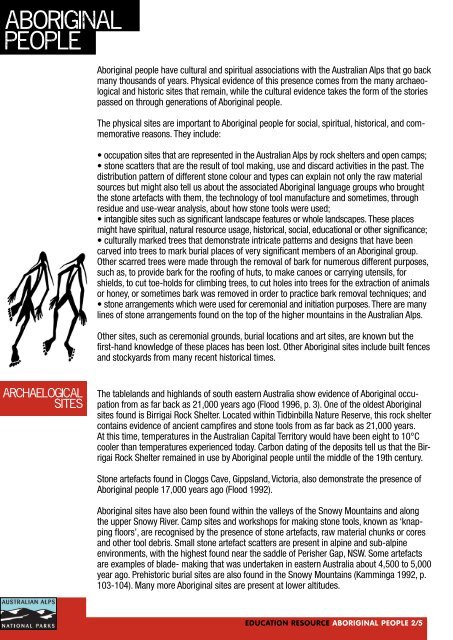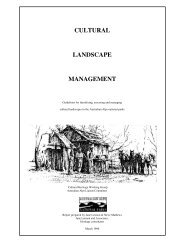Aboriginal People and the Australian Alps (pdf)
Aboriginal People and the Australian Alps (pdf)
Aboriginal People and the Australian Alps (pdf)
Create successful ePaper yourself
Turn your PDF publications into a flip-book with our unique Google optimized e-Paper software.
aboriginalpeople<strong>Aboriginal</strong> people have cultural <strong>and</strong> spiritual associations with <strong>the</strong> <strong>Australian</strong> <strong>Alps</strong> that go backmany thous<strong>and</strong>s of years. Physical evidence of this presence comes from <strong>the</strong> many archaeological<strong>and</strong> historic sites that remain, while <strong>the</strong> cultural evidence takes <strong>the</strong> form of <strong>the</strong> storiespassed on through generations of <strong>Aboriginal</strong> people.The physical sites are important to <strong>Aboriginal</strong> people for social, spiritual, historical, <strong>and</strong> commemorativereasons. They include:• occupation sites that are represented in <strong>the</strong> <strong>Australian</strong> <strong>Alps</strong> by rock shelters <strong>and</strong> open camps;• stone scatters that are <strong>the</strong> result of tool making, use <strong>and</strong> discard activities in <strong>the</strong> past. Thedistribution pattern of different stone colour <strong>and</strong> types can explain not only <strong>the</strong> raw materialsources but might also tell us about <strong>the</strong> associated <strong>Aboriginal</strong> language groups who brought<strong>the</strong> stone artefacts with <strong>the</strong>m, <strong>the</strong> technology of tool manufacture <strong>and</strong> sometimes, throughresidue <strong>and</strong> use-wear analysis, about how stone tools were used;• intangible sites such as significant l<strong>and</strong>scape features or whole l<strong>and</strong>scapes. These placesmight have spiritual, natural resource usage, historical, social, educational or o<strong>the</strong>r significance;• culturally marked trees that demonstrate intricate patterns <strong>and</strong> designs that have beencarved into trees to mark burial places of very significant members of an <strong>Aboriginal</strong> group.O<strong>the</strong>r scarred trees were made through <strong>the</strong> removal of bark for numerous different purposes,such as, to provide bark for <strong>the</strong> roofing of huts, to make canoes or carrying utensils, forshields, to cut toe-holds for climbing trees, to cut holes into trees for <strong>the</strong> extraction of animalsor honey, or sometimes bark was removed in order to practice bark removal techniques; <strong>and</strong>• stone arrangements which were used for ceremonial <strong>and</strong> initiation purposes. There are manylines of stone arrangements found on <strong>the</strong> top of <strong>the</strong> higher mountains in <strong>the</strong> <strong>Australian</strong> <strong>Alps</strong>.O<strong>the</strong>r sites, such as ceremonial grounds, burial locations <strong>and</strong> art sites, are known but <strong>the</strong>first-h<strong>and</strong> knowledge of <strong>the</strong>se places has been lost. O<strong>the</strong>r <strong>Aboriginal</strong> sites include built fences<strong>and</strong> stockyards from many recent historical times.archaelogicalsitesThe tablel<strong>and</strong>s <strong>and</strong> highl<strong>and</strong>s of south eastern Australia show evidence of <strong>Aboriginal</strong> occupationfrom as far back as 21,000 years ago (Flood 1996, p. 3). One of <strong>the</strong> oldest <strong>Aboriginal</strong>sites found is Birrigai Rock Shelter. Located within Tidbinbilla Nature Reserve, this rock sheltercontains evidence of ancient campfires <strong>and</strong> stone tools from as far back as 21,000 years.At this time, temperatures in <strong>the</strong> <strong>Australian</strong> Capital Territory would have been eight to 10°Ccooler than temperatures experienced today. Carbon dating of <strong>the</strong> deposits tell us that <strong>the</strong> BirrigaiRock Shelter remained in use by <strong>Aboriginal</strong> people until <strong>the</strong> middle of <strong>the</strong> 19th century.Stone artefacts found in Cloggs Cave, Gippsl<strong>and</strong>, Victoria, also demonstrate <strong>the</strong> presence of<strong>Aboriginal</strong> people 17,000 years ago (Flood 1992).<strong>Aboriginal</strong> sites have also been found within <strong>the</strong> valleys of <strong>the</strong> Snowy Mountains <strong>and</strong> along<strong>the</strong> upper Snowy River. Camp sites <strong>and</strong> workshops for making stone tools, known as ‘knappingfloors’, are recognised by <strong>the</strong> presence of stone artefacts, raw material chunks or cores<strong>and</strong> o<strong>the</strong>r tool debris. Small stone artefact scatters are present in alpine <strong>and</strong> sub-alpineenvironments, with <strong>the</strong> highest found near <strong>the</strong> saddle of Perisher Gap, NSW. Some artefactsare examples of blade- making that was undertaken in eastern Australia about 4,500 to 5,000year ago. Prehistoric burial sites are also found in <strong>the</strong> Snowy Mountains (Kamminga 1992, p.103-104). Many more <strong>Aboriginal</strong> sites are present at lower altitudes.EDUCATION RESOURCE ABORIGINAL PEOPLE 2/5
















